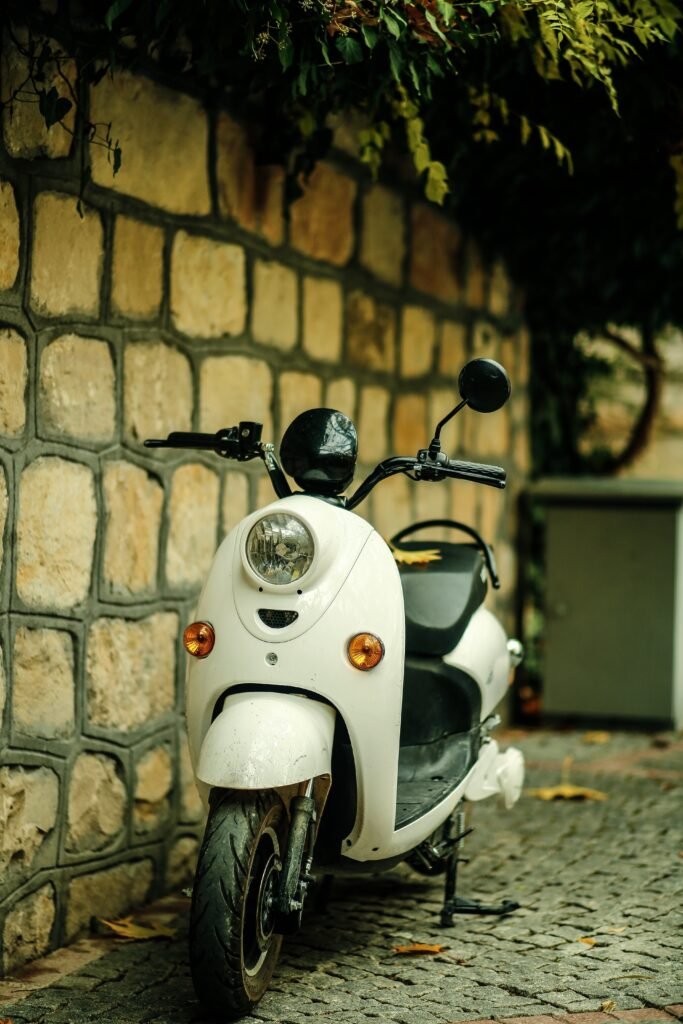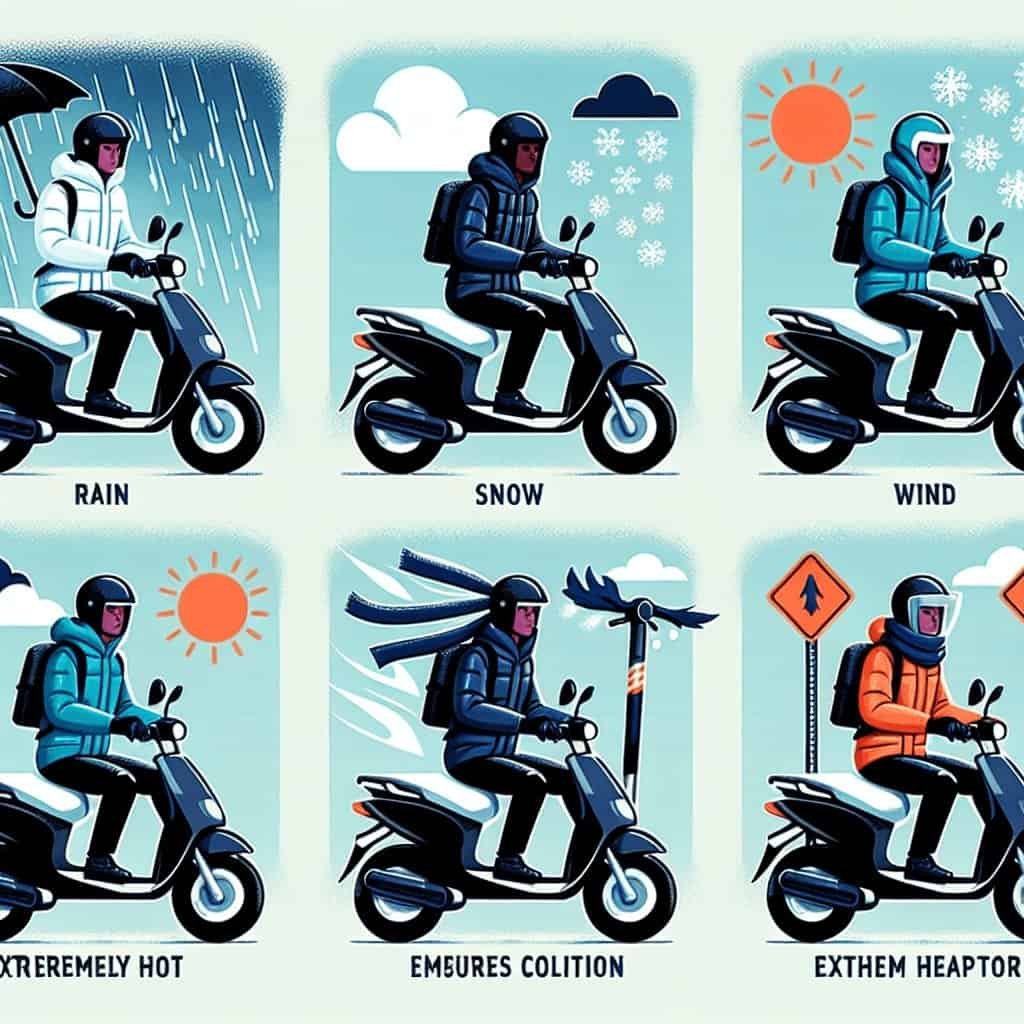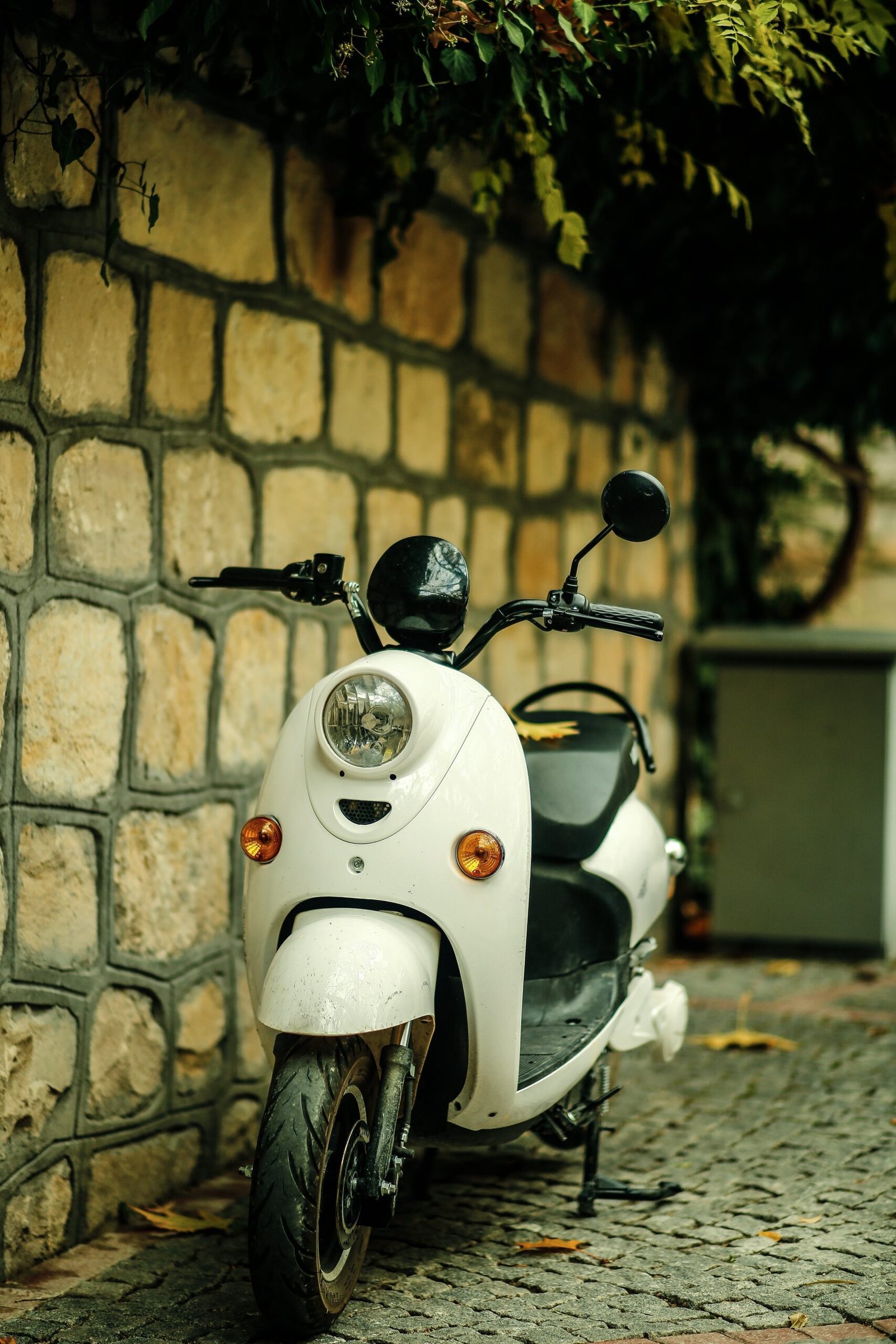Are you an avid electric scooter rider? Do you find yourself wondering if there are any specific guidelines to follow when riding your scooter in extreme weather conditions? Whether it’s scorching heat or heavy rain, it’s important to ensure your safety and the longevity of your scooter. This article will explore the best practices for riding your electric scooter in extreme weather, providing you with essential tips to navigate any challenging conditions. So, before you venture into the unknown, read on to learn how to conquer the elements and continue enjoying the thrilling experience of riding your electric scooter.

Preparing Your Electric Scooter for Extreme Weather
Check the battery
Before heading out in extreme weather conditions, it’s important to check the battery of your electric scooter. Cold temperatures can affect battery performance, so make sure it is fully charged before you hit the road. Consider investing in a battery cover to help insulate the battery and maintain its temperature.
Inspect the tires
Tires are crucial for maintaining grip and stability, especially in extreme weather. Before riding in extreme conditions, check the condition of your scooter’s tires. Make sure they have sufficient tread depth to handle wet or icy surfaces. Consider using winter tires or tire chains for better traction in snowy or icy conditions.
Protect the electronics
Extreme weather conditions can damage the electronics of your electric scooter. To protect them, consider using a waterproof cover or bag to shield the scooter from rain or snow. It’s also a good idea to avoid exposing the scooter to direct sunlight for prolonged periods, as excessive heat can affect the performance of the electronics.
Ensure visibility
In extreme weather, visibility becomes crucial for both your safety and the safety of others on the road. Make sure all lights on your electric scooter are in working order and clean. Additionally, consider using reflective tape or stickers to enhance your scooter’s visibility. A brightly colored safety vest can also help make you more visible to other road users.
Riding Techniques for Extreme Weather
Control your speed
In extreme weather conditions, it’s important to adjust your speed accordingly. Reduce your speed to maintain better control over your electric scooter. Riding at a slower pace allows you more time to react to any sudden changes or obstacles on the road.
Maintain a safe distance
When riding in extreme weather, it’s essential to maintain a safe distance from other vehicles. Wet or icy roads can significantly increase braking distances, so keeping a safe following distance can help prevent accidents. Leave enough space between your scooter and the vehicle ahead to ensure your safety.
Use proper hand signals
Hand signals are essential for communicating your intentions to other road users. When riding in extreme weather, it becomes even more important to use proper hand signals to indicate your turns or stops. Be clear and confident when signaling, ensuring other road users are aware of your intentions.
Avoid sudden braking or acceleration
In extreme weather conditions, sudden braking or acceleration can result in loss of control. Gradually apply the brakes or accelerate to avoid skidding or losing traction. Smooth movements will help maintain stability and keep you safe on the road.
Navigating in Rainy Conditions
Wear appropriate gear
When riding in rainy conditions, it’s crucial to wear appropriate gear to stay dry and comfortable. Invest in a waterproof jacket and pants to protect yourself from rainwater. Waterproof gloves and boots are also important to keep your hands and feet dry and maintain a good grip on the scooter’s controls.
Slow down and increase braking distance
Rainy conditions can make the road slippery, reducing traction. To stay safe, slow down and increase your braking distance. Give yourself more time to stop by applying the brakes earlier than usual. This will help prevent skidding and ensure a safe ride.
Avoid standing water
Standing water can conceal potholes, debris, or uneven surfaces, making it hazardous for electric scooter riders. It’s best to avoid riding through puddles or standing water whenever possible. If you must ride through a puddle, approach it slowly and try to maintain a straight path to minimize splashing and the risk of losing control.
Maintain a steady grip
Rain can make the handlebars and controls of your electric scooter slippery. To maintain a steady grip, wipe off any moisture from the handlebars and ensure your hands are dry. Consider using gloves with a good grip or applying grip-enhancing products to the handlebars for better control.
Scooter Safety in Snow and Ice
Use winter tires or chains
In snowy or icy conditions, regular scooter tires may not provide sufficient traction. Consider using winter tires or installing tire chains specifically designed for electric scooters. These provide better grip on slippery surfaces, enhancing your safety while riding in snow or ice.
Lower tire pressure for traction
Lowering the tire pressure slightly can increase the surface area of the tire in contact with the road, improving traction in snowy or icy conditions. However, make sure not to lower the pressure excessively, as it can affect stability and handling.
Avoid sharp turns or quick maneuvers
When riding in snow or ice, it’s best to avoid sharp turns or sudden maneuvers. These can cause the scooter to lose traction and lead to accidents. Instead, take wider turns and make slow, controlled movements to maintain stability on slippery surfaces.
Be cautious of black ice
Black ice is a thin, transparent layer of ice that forms on the road surface. It is extremely slippery and can be difficult to spot. When riding in cold conditions, be extra cautious and keep an eye out for potential black ice patches. Reduce your speed and maintain a steady grip on the scooter’s handlebars to avoid losing control.

Tips for Riding in Extremely Hot Weather
Stay hydrated
In extremely hot weather, staying hydrated is crucial for your well-being and safety. Carry a water bottle with you and drink regularly to prevent dehydration. Dehydration can affect your concentration and reaction time, increasing the risks of accidents while riding your electric scooter.
Wear breathable clothing
When riding in hot weather, wearing appropriate clothing is essential for comfort and safety. Choose lightweight, breathable fabrics that allow air circulation and help wick away sweat. Wearing a helmet with ventilation can also help keep you cool during your ride.
Avoid prolonged exposure to direct sunlight
Excessive exposure to direct sunlight can lead to heat exhaustion or heatstroke. If possible, try to ride your scooter during the cooler parts of the day or in shaded areas. Take breaks in shaded areas to give yourself time to cool down and avoid overheating.
Take breaks to cool down
Riding in extremely hot weather can cause fatigue and discomfort. Take regular breaks to cool down and rest. Find shaded areas or air-conditioned spaces where you can refresh yourself before continuing your ride.
Handling High Winds
Keep a firm grip on the handlebars
When riding in high winds, it’s important to maintain a firm grip on the handlebars to maintain control of your electric scooter. Wind gusts can cause instability, so hold onto the handlebars with both hands and keep a firm, steady grip.
Lean into the wind
To counteract the force of high winds, lean into the wind instead of resisting it. By leaning into the wind, you can maintain better stability and reduce the risk of being blown off course.
Reduce speed and maintain stability
High winds can affect your scooter’s stability, particularly when riding at higher speeds. To stay safe, reduce your speed and maintain stability by keeping both hands on the handlebars and your body centered over the scooter. This will help you maintain control and make it easier to react to any sudden gusts of wind.
Stay away from wind tunnels or open spaces
When riding in high winds, try to avoid areas known for strong gusts, such as wind tunnels or open spaces without any windbreaks. These areas can intensify the force of the wind and make it more challenging to control your scooter. Stick to sheltered routes whenever possible.

Dealing with Foggy Conditions
Use fog lights or headlights
In foggy conditions, visibility is significantly reduced. Make sure your electric scooter is equipped with fog lights or headlights and use them to improve your visibility to other road users. Having properly functioning lights can help prevent accidents and ensure your safety on the road.
Ride at a slower pace
When navigating through fog, it’s important to reduce your speed. Fog can impair visibility, making it difficult to see potential hazards or obstacles in time. Slowing down allows you more time to react and increases your overall safety.
Maintain a safe distance from other vehicles
In foggy conditions, it’s crucial to maintain a safe distance from other vehicles on the road. Reduced visibility makes it challenging to judge distances accurately. Keep a safe following distance to allow for sudden stops or changes in traffic flow.
Be cautious of reduced visibility
Fog can significantly reduce visibility, making it harder for both you and other road users to see each other. Stay alert and be prepared for unexpected situations. Keep an eye out for headlights or other indicators of vehicles ahead and be extra cautious at intersections or crosswalks.
Riding Safely in Thunderstorms
Seek shelter before the storm hits
When thunderstorms are forecasted, it’s best to seek shelter and wait until the storm passes before using your electric scooter. Riding in thunderstorms can be extremely dangerous due to the risk of lightning strikes, high winds, and torrential rain.
Avoid touching metal surfaces
During a thunderstorm, it’s important to avoid touching metal surfaces on your electric scooter. Metal is a good conductor of electricity and can increase the risk of getting struck by lightning. Seek shelter indoors or find covered areas away from metal structures if you get caught in a storm.
Maintain a safe distance from power lines
If you must ride during a thunderstorm, be aware of your surroundings and maintain a safe distance from power lines. Storms can cause power lines to become unstable or fall, posing significant danger to anyone nearby. Avoid riding near power lines or any other structures that may be at risk of damage.
Wear proper rain gear and insulation
When riding in a thunderstorm, it’s important to protect yourself from the elements. Invest in high-quality rain gear, such as a waterproof jacket and pants, to keep yourself dry. Additionally, consider wearing insulated clothing to stay warm in case of strong winds or a drop in temperature.

Staying Safe in Winter Downpours
Use waterproof gear and covers
Winter downpours can quickly soak through regular clothing and accessories. Invest in waterproof gear, including pants, jackets, and gloves, to keep yourself dry. Additionally, consider using waterproof covers for your electric scooter to protect it from water damage.
Ensure proper visibility with clear visors
Visibility is crucial while riding in winter downpours. Make sure your helmet has a clear visor that won’t fog up easily. Anti-fog treatments or inserts can also be used to maintain clear visibility, allowing you to see the road and potential hazards clearly.
Beware of slippery road surfaces
In winter downpours, road surfaces can become extremely slippery. Be cautious when riding and avoid sudden acceleration or braking that may cause your scooter to skid. Take extra care when going around corners or intersections to prevent accidents.
Avoid puddles and low-lying areas
Puddles and low-lying areas can conceal hazards or deep potholes, making them potentially dangerous to ride through in winter downpours. Try to avoid these areas whenever possible to minimize the risk of losing control or damaging your electric scooter.
Safety Precautions in Extreme Heatwaves
Check battery temperature limits
Extreme heat can affect the performance and lifespan of your scooter’s battery. Check the manufacturer’s guidelines for the recommended temperature operating range and make sure you do not exceed it. If necessary, avoid riding in extreme heat or find shaded areas to park your electric scooter.
Avoid overcharging the scooter
Overcharging can lead to excessive heat build-up in the battery, reducing its overall lifespan. Be mindful of the charging duration recommended by the manufacturer and avoid leaving the scooter connected to the charger for prolonged periods. Disconnect the charger once the battery is fully charged.
Park in shaded areas when not in use
Whenever possible, park your electric scooter in shaded areas to protect it from direct sunlight. Extreme heat can damage the scooter’s electronics and affect the battery’s performance. By parking in shaded areas, you can help maintain optimal operating conditions for your scooter.
Protect exposed skin against sunburn
When riding in extreme heat, exposed skin can be susceptible to sunburn. To protect yourself, apply sunscreen with a high SPF, wear a wide-brimmed hat, and use sunglasses to shield your eyes from the sun’s harmful rays. Protecting your skin can help prevent discomfort and potential health issues.
In conclusion, riding your electric scooter in extreme weather conditions requires some precautions and adjustments. By following these guidelines, you can ensure your safety on the road and maintain the longevity of your scooter. Remember to always prioritize your well-being and adjust your riding techniques accordingly when facing challenging weather conditions. Stay informed, be prepared, and ride responsibly to fully enjoy your electric scooter adventure in any weather!


